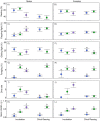Eating locally: Australasian gannets increase their foraging effort in a restricted range
- PMID: 26369928
- PMCID: PMC4610223
- DOI: 10.1242/bio.013250
Eating locally: Australasian gannets increase their foraging effort in a restricted range
Abstract
During the breeding season, seabirds adopt a central place foraging strategy and are restricted in their foraging range by the fasting ability of their partner/chick and the cost of commuting between the prey resources and the nest. Because of the spatial and temporal variability of marine ecosystems, individuals must adapt their behaviour to increase foraging success within these constraints. The at-sea movements, foraging behaviour and effort of the Australasian gannet (Morus serrator) was determined over three sequential breeding seasons of apparent differing prey abundance to investigate how the species adapts to inter-annual fluctuations in food availability. GPS and tri-axial accelerometer data loggers were used to compare the degree of annual variation within two stages of breeding (incubation and chick rearing) at a small gannet colony situated between two larger, nearby colonies. Interestingly, neither males nor females increased the total distance travelled or duration of foraging trip in any breeding stage (P>0.05 in all cases) despite apparent low prey availability. However, consistently within each breeding stage, mean vectorial dynamic body acceleration (an index of energy expenditure) was greater in years of poorer breeding success (increased by a factor of three to eight), suggesting birds were working harder within their range. Additionally, both males and females increased the proportion of a foraging trip spent foraging in a poorer year across both breeding stages. Individuals from this colony may be limited in their ability to extend their range in years of low prey availability due to competition from conspecifics in nearby colonies and, consequently, increase foraging effort within this restricted foraging area.
Keywords: Accelerometry; Foraging ecology; Inter-annual; Morus serrator.
© 2015. Published by The Company of Biologists Ltd.
Conflict of interest statement
The authors declare no competing or financial interests.
Figures


References
-
- Abrams P. A. (1991). Life history and the relationship between food availability and foraging effort. Ecology 72, 1242-1252. 10.2307/1941098 - DOI
-
- Adams E. S. (2001). Approaches to the study of territory size and shape. Annu. Rev. Ecol. Syst. 32, 277-303. 10.1146/annurev.ecolsys.32.081501.114034 - DOI
-
- Berlincourt M. and Arnould J. P. Y. (2015a). Influence of environmental conditions on foraging behaviour and its consequences on reproductive performance in little penguins. Mar. Biol. 162, 1485-1501. 10.1007/s00227-015-2685-x - DOI
LinkOut - more resources
Full Text Sources
Other Literature Sources

